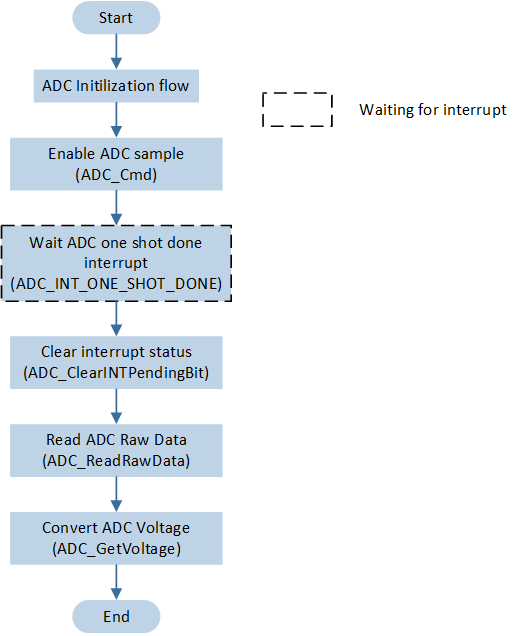One Shot Polling
This sample demonstrates one shot voltage sampling using an ADC in polling mode.
ADC sampling is performed by polling the ADC_INT_ONE_SHOT_DONE interrupt. When the interrupt flag is detected as 1, it indicates that the sampling is complete, and the raw data is read for voltage conversion calculation.
Users can change the sampling mode of the ADC channel, input voltage range, and other information in the sample through different macro configurations. For specific macro configurations, see Configurations.
Requirements
For requirements, please refer to the Requirements.
Wiring
Use a Dupont wire to connect P2_4 to external voltage input.
Configurations
-
The following macro can be configured to modify the ADC sample mode.
#define ADC_DEMO_POLLING 0 /*< ADC One Shot Polling Mode. */ #define ADC_DEMO_AVERAGE 1 /*< ADC One Shot Polling Average Mode. */ #define ADC_DEMO_MODE ADC_DEMO_POLLING /*< Set this macro to select the ADC sample mode. */
-
The following macro can be configured to modify the ADC input voltage range.
#define ADC_DIVIDE_MODE 1 /*< Divide Mode, input voltage range is 0V~Vbat. */ #define ADC_BYPASS_MODE 0 /*< Bypass Mode, input voltage range is 0V~0.9V. */ #define ADC_MODE_DIVIDE_OR_BYPASS ADC_DIVIDE_MODE /*< Set this macro to select the ADC input voltage range. */
-
The following macro can be configured to modify the pin definitions.
#define ADC_SAMPLE_PIN P2_4 #define ADC_SAMPLE_CHANNEL ADC_Channel_Index_4
Building and Downloading
For building and downloading, please refer to the Building and Downloading.
Experimental Verification
-
When the EVB starts, observe the following log within the Debug Analyzer.
Start adc polling test!
-
ADC Configurations:
-
If
ADC_MODE_DIVIDE_OR_BYPASSis configured asADC_DIVIDE_MODE, the following log will be printed:[ADC]ADC sample mode is divide mode !
-
If
ADC_MODE_DIVIDE_OR_BYPASSis configured asADC_BYPASS_MODE, the following log will be printed:[ADC]ADC sample mode is bypass mode !
-
-
After initialization is complete, the ADC begins sampling. Once a single ADC sampling is finished, the raw data collected and the converted voltage values will be printed in the Debug Analyzer tool.
[ADC] adc_sample_demo: ADC one shot mode sample data_0 = xxx, voltage_0 = xxx mV ... [ADC] adc_sample_demo: ADC one shot mode sample data_15 = xxx, voltage_15 = xxx mV
Code Overview
This section introduces the code and process description for initialization and corresponding function implementation in the sample.
Source Code Directory
The directory for project file and source code are as follows:
Project directory:
sdk\samples\peripheral\adc\oneshot_polling\projSource code directory:
sdk\samples\peripheral\adc\oneshot_polling\src
Initialization
The initialization flow for peripherals can refer to Initialization Flow in General Introduction.
-
Call
Pad_Config()andPinmux_Config()to configure the PAD and PINMUX of the corresponding pins. Please ensure that the PAD is configured in Shutdown mode to prevent leakage.void board_adc_init(void) { Pad_Config(ADC_SAMPLE_PIN, PAD_SW_MODE, PAD_NOT_PWRON, PAD_PULL_NONE, PAD_OUT_DISABLE, PAD_OUT_LOW); }
Call
RCC_PeriphClockCmd()to enable the ADC clock.-
Initialize the ADC peripheral:
Define the
ADC_InitTypeDeftypeADC_InitStruct, and callADC_StructInit()to pre-fillADC_InitStructwith default values.Modify the
ADC_InitStructparameters as needed. WhenADC_DEMO_MODEis configured with different values, the initialization configuration will be different. The ADC initialization parameter configuration is shown in the table below.Call
ADC_Init()to initialize the ADC peripheral.
ADC Hardware Parameters |
Setting in the |
|
|
|---|---|---|---|
Sample Time |
255 |
255 |
|
Schedule Index |
All index is set to |
Only index 0 is set to |
|
Bit Map |
0xFFFF |
0x01 |
|
Data Average Enable or Disable |
|||
Data Average number |
- |
||
Power Always On |
If
ADC_MODE_DIVIDE_OR_BYPASSis configured asADC_BYPASS_MODE, the functionADC_BypassCmd()must be called to enable the Bypass mode for the corresponding pin.Call
ADC_INTConfig()to configure the ADC one shot done interruptADC_INT_ONE_SHOT_DONE.Before the ADC begins sampling, it is necessary to call
ADC_CalibrationInit()for ADC voltage calibration. If the return value is false, it indicates that the IC has not been calibrated and cannot accurately convert voltage values, but raw data can still be read.
Note
For the Average mode of the ADC, it is only applicable to channel 0; other channels cannot perform Average sampling. The Schedule Index configuration of the ADC must be configured starting from 0.
Functional Implementation
The flow for ADC one shot polling mode is shown in the figure:

ADC one shot polling mode flow
Call
ADC_Cmd()to start ADC sampling.Continuously check the ADC one shot done interrupt
ADC_INT_ONE_SHOT_DONEstatus and wait for the ADC single sampling to complete.-
Call the
ADC_ReadRawData()function to read the sampled data from the corresponding channel. Call theADC_GetVoltage()function, input the corresponding sampling mode, and convert the sampled data into a voltage value.while (ADC_GetINTStatus(ADC, ADC_INT_ONE_SHOT_DONE) == RESET) {} ADC_ClearINTPendingBit(ADC, ADC_INT_ONE_SHOT_DONE); ... sample_data[i] = ADC_ReadRawData(ADC, ADC_Schedule_Index_0 + i); sample_voltage[i] = ADC_GetVoltage(DIVIDE_SINGLE_MODE, (int32_t)sample_data[i], &error_status);
Note
If configure ADC_DEMO_MODE as ADC_DEMO_AVERAGE, the integer part of the sampled data needs to be extracted for voltage conversion, while the fractional part is not yet supported for voltage conversion.
See Also
Please refer to the relevant API Reference: